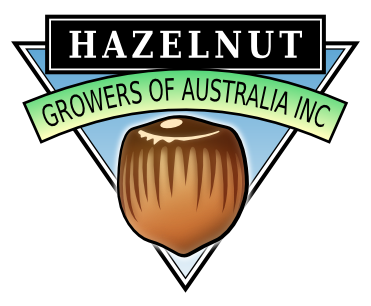The Australian Hazelnut Program of Research (AUSHAZ) is a five-year, $2 million AgriFutures Australia investment led by Charles Sturt University in concert with a consortium of research and industry partners. It is focused on twelve priorities grouped under three themes with the objective of optimising hazelnut production in Australia, developing quality standards and an industry framework and driving growth through innovation and communication.
“By conducting a series of carefully designed inter-connected projects that target priorities identified in the Australian Hazelnut 2030 Strategic Blueprint, the program is aiming to provide solutions to major current and near future issues that constrain growth,”
Hazelnut Growers of Australia Executive Officer, Trevor Ranford.
Theme 1 – Production
Field experimentation and survey methods are being used to capture data on parameters such as water and nutrient optimisation and identity the severity of hazelnut diseases present in production districts. Some of the production issues including pollination, water and nutrient management, tree physiology and development and plant protection.
An example of the R&D:
Develop methods and tools to be used for studying the parameters that influence the conversion of flowers to nuts in hazelnuts. This will support developing procedures to optimise the supply of nutrients and water in managing hazelnut trees to achieve targeted yields and quality, by automating the estimation of flower and final hazelnut counts with images from the canopy.
Theme 2 - Benchmarking
Work in the benchmarking theme is using desktop research methodologies to develop the sustainability framework and data science approaches to create a statistical base for the industry. Laboratory and field studies are also being used to assess quality aspects of hazelnuts and products to support domestic and international marketing programs.
An example of the R&D:
Develop a benchmarking framework for the Australian hazelnut industry including mapping and comparing different Australian orchards, their production efficiency, sustainability, profitability, financial stability, as well as the quality of the hazelnut primary and by-products produced.
A comprehensive benchmarking survey is to be distributed to collect the comprehensive range of data from the targeted hazelnut orchards, geolocated by Applied Agricultural Remote Sensing Centre (AARSC).
Theme 3 – Communications & Extension
The communications and extension theme is intending to develop and use a coordinated series of grower-facing devices to ensure that findings are delivered for maximum real – world impact.
This theme will aim to give growers benefit from new knowledge and emerging technologies to sustainably grow the industry, ensuring product quality and protection from biosecurity threats.
An example of the R&D:
Current practices in hazelnut drying are being identified through grower interviews and field trips to contribute to the implementation of innovative farm management standards. A systematic study will explore optimal drying techniques, temperature settings, airflow control, and dryer design. Pilot-scale experiments for on-farm drying optimisation, directly engaging with growers, will test these methods under real-world conditions, as well as changes in nut quality during storage, offering insights into long-term storage viability.
